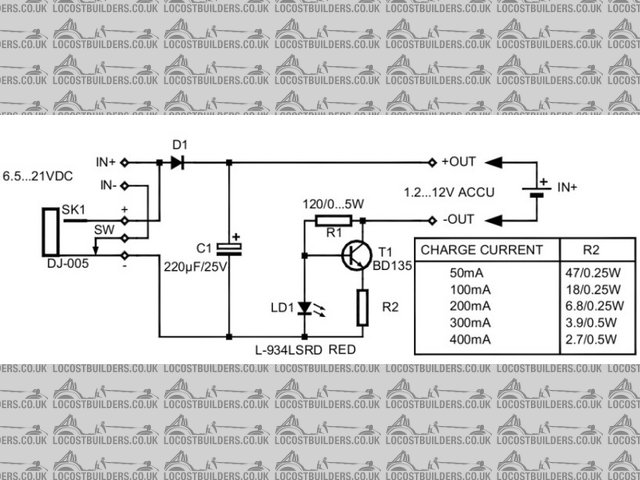
nimh battery charger - any electronics people inthe house ?
givemethebighammer - 22/10/09 at 02:02 PM
OK so not strictly for the car but still electrical.
I'm building a charger for some nimh battery packs. The packs are 12v 2700mah, I found a kit that lets me use a standard dc power adapter to
charge batteries. I will be using an input / output voltage of 18v and want an output current of 270mA. This can be achieved by changing the resistor
R2 on the PCB. The schematic only lists 50mA, 100mA, 200mA, 300mA and 400mA. The question is do I just go for 300mA or is there a more precise way of
calculating the resistor value for 270mA ? I'm aiming to get as close as possible to a C10 charge rate.
thanks


Rescued attachment charger.jpg
SeaBass - 22/10/09 at 02:20 PM
Not too scientific but if you plot a graph of those values the nearest resistor value for you current requirements is 4.7 elephants or whatever the
order the value is given as...
[Edited on 22/10/09 by SeaBass]
BenB - 22/10/09 at 02:40 PM
I'd put a variable resistor in place and adjust it with the battery connected 
Bluemoon - 22/10/09 at 03:06 PM
^^ both of these methods will work well enough.. A 10C rate is normally o.k if left on almost indefinatly although, I would not advise it), so I would
be happy if you get to within say 5 to 10% of the current you want..
Dan
Bluemoon - 22/10/09 at 03:08 PM
I have a CPC wall wart constant current charger (has about 6 different current settings), only cost a fiver.. I'd only bother building a simple
constant current one if you want to play with some electronics..
Dan
MikeRJ - 22/10/09 at 03:29 PM
quote:
Originally posted by givemethebighammer
is there a more precise way of calculating the resistor value for 270mA ? I'm aiming to get as close as possible to a C10 charge rate.
thanks
The theory is as follows:
The LED is used as a voltage reference. A typical red LED will have a forward voltage of somewhere in the region of 2v. This reference voltage is
applied to the base of the transistor. We know the voltage drop from base to emitter (Vbe) is around 0.6v, so this gives a nominal voltage on the
emitter of 2-0.6=1.4 volts. This is the voltage applied across the sense resistor R2, so the current through the sense resistor can be calulated from
Ohms law (I=V/R). The collector current in a bipolar transistor is approximately equal to the emitter current (assuming small base current), so with
a fixed voltage on the base, you get a constant collector current which is what charges the battery.
Problems:
1) The Vf of LEDs has a broad manufacturing distribution; the data sheet for the device specified shows 1.75v nominal and 2.5v max for a fixed current
of 2ma. This immediately gives a 42% uncertainty in current.
2) The Vf of the LED varies with the current going through it. In this case, the forward current is derived from a resistor connected to the battery,
so forward current will vary according to the battery voltage and to the rectified DC voltage across C1. A nominal 12v NiMH pack has 10 cells, so has
a possible variation from 10v when completely exhausted to maybe 14v when fully charged.
3) The Vf varies with temperature. The datasheet doesn't even say what the temperature coefficient is, since it not important if you are using
the LED as intended, i.e. not as a voltage reference!
4) Vbe will have some manufacturing spread, nothing like as big as the LED however.
5) Vbe varies with temperature. This is a fairly linear and predictable change of around 2mV/degree C.
This all adds up to a very crude current source (actually current sink) that is only one step better than a simple resistor to limit current. Given
the large variations in the reference voltage it would be impossible to predict what value resistor you need for a given current, and even then that
value would be correct only for a given temperature and battery voltage.
If you really want precise currents you will need something more sophisticated. The simplest approach would be an
LM317T voltage regulator configured as a current source. These are cheap to buy, and will give
orders of magnitude better performance than the transistor circuit above, whilst being a simpler solution.
givemethebighammer - 22/10/09 at 04:59 PM
Thanks for the replies, few different ways of looking at the problem. Bluemoon do you have a link to that CPC charger, it might save me some time and
effort.
Bluemoon - 27/10/09 at 01:25 PM
Charger linky
http://cpc.farnell.com/_/mw2168/universal-plug-in-n
i-cad-ni-mh/dp/BT03388?MER=e-bb45-00001003
It's just a constant current source. Mine did not have the ability to switch automatically to trickle charge (I expect the product description is
wrong, i bet the one in the link will not do this as well!)..
Mine actually had a fault on it, turned out to be dry joints, just opened it up and re-soldered..
Dan
[Edited on 27/10/09 by Bluemoon]
givemethebighammer - 27/10/09 at 10:41 PM
Thanks Dan, is 14v enough to charge a 12v battery, I thought you would need 18-21v ??
MikeRJ - 28/10/09 at 10:24 AM
Terminal voltage for a 10 cell NiMH will be in the region of 14v, and it says it's good for up to 10 cells.



